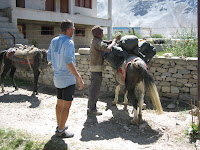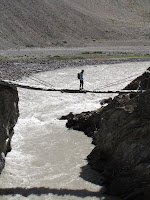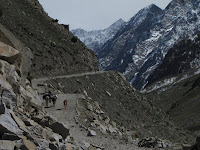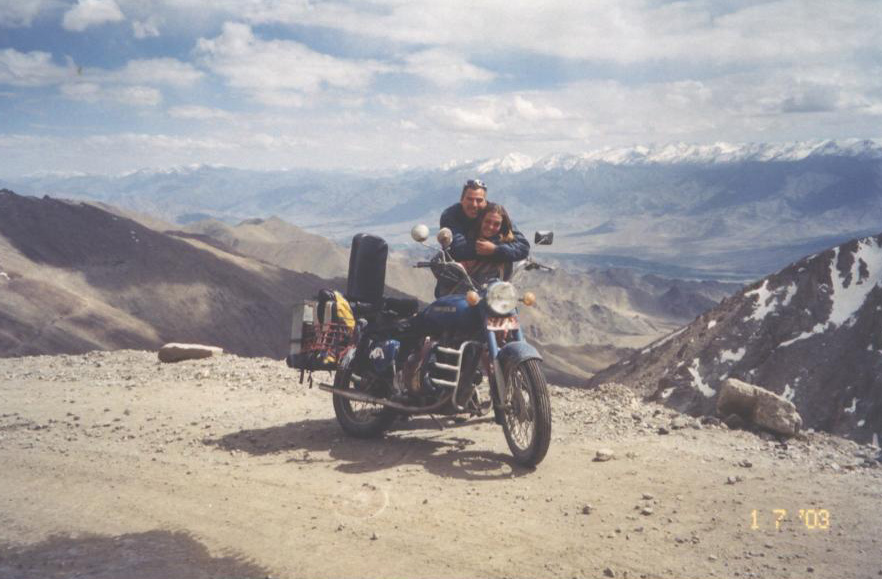Gal’s master-plan, for some time now, was to cycle till the
end of the road and then trek over the Greater Himalaya Range, back to civilization.
What a way to end our trip!
The advantages were obvious. First, we’ll finally have an
opportunity to hike, instead of constantly cycling. Second, we’ll avoid the
notorious 2-day bus journey from Leh to Manali (plus the 2-days hectic journey from
Padum to Leh).
A bit of history
The first time we heard of the trek was 8 years ago. We were
at Kargil, during our motorcycle trip, when we met 2 trekkers, who just ended a
28-day trek from Manali to Kargil. Gal added that to her TODO list.
9 months ago, at an Internet-café in Trujillo, Peru, while
doing our homework regarding the India Himalayas Bicycle Trip, Gal read a
cyclist’s blog,
which had a picture of the beautiful glacier at Pensi La.
So, the plan was to reach Padum, find a horseman and go. So
easy…
Rami – always the pessimist
We have already learned that Rami is always pessimist.
Rami reminded Gal that at Keylong, a month ago, we met a
cyclist and an Israeli trekker, who have just finished the same trek we were
planning. They informed us that finding a horseman for a tiny group of 2, with
no ‘kitchen tent’, ‘Toilet tent’ and the whole ‘expedition’ thing is difficult
and that prices of horses can go up to 1,000 rupee (over $20) per horse per day.
2 horses, 10 days… what if we don’t find horses?
What about bad weather?
How long will we wait, stuck, at Padum?
Our horseman 24/8
We just reached Padum, cycling ‘downtown’ directly to the
neglected government guesthouse (J & K tourist bungalow).
While parking our bikes, an old local approached and offered
his services (in broken English) as a horseman:
“horseman – horseman?”
“how much?”
“300 per horse, 3 horses”
“deal”
And we had our horseman!
Hopefully we’ll get his name the next time we meet.
It was time to get a
room and have our long awaited shower!
Padum
Padum is one of the last ‘Wild West’ towns we've encountered
in our many travels.
After a terrible 240KM road from Kargil, you reach this
tiny, dusty, 1-street town.
The ‘center’ is “the” junction (a T-junction, not even a
full one!). Walking around you mainly see convenience stores, all the same,
basic, concrete, boring.
There was an Internet café, that never had connection. A few
hotels and awful restaurants for tourists.
A year & a half later we visited again, while trekking
the area, and there were already 3 Internet cafés, usually with no connection. Nothing
changed ;-)
We stayed 3 night at Padum; a bit more than needed for
catching all the major sights ;-)
But we needed the rest and to stock supplies for the trek.
We even found where to get kerosene! Tourists can’t buy kerosene in India – it’s
subsidized. We needed quite a lot for
the trek.
Our horseman gave us a shopping list, including lots of flour
and other basic stuff, not the standard things you take for hiking. We were
lucky he took charge of the kitchen. He probably had experience with westerners
cooking in these areas.
Trekking 27/8
Tsering Gatok, our horseman, arrived at 09:22 – thank god.
Till that moment Rami was expecting the worse, like him skipping with our
deposit. He took one of the buns Rami bought from the bakery and stashed it deep
in his ‘Mary Poppins bag’.
It took us over an hour to load all the stuff on the horses.
First time is always the longest.
And we were off, to Raru, a small village on the way.





The route was already a dirt road. The India government has been working for a long time on building this road to take place of the terrible Manali-Leh highway, which is closed half the year and is extremely expensive to maintain. The new route will have only 1 pass (after a tunnel will bypass Rohtang La – yah, let’s see you dare go through that tunnel ;-)







It was a very easy day. We rode the whole way. Carrying no luggage was a refreshing change. Tsering was far behind, what raised the question of how and where will we meet up? We stopped at a village (every single house in remote areas is a village) and waited. 2 hours later Tsering arrived. We continued together till a house at the outskirts of Raru, friends of Tsering. We camped there and cooked in their warm house. Rami collected pees from their fields. Tsering pulled a leg of a goat from his bag and chopped a bit of it for the dinner stew. That goat leg will be going a long way with us.
Interesting that the following morning the pees left us just as they entered. We were interested of how Tsering tackled those pees.






Walking 28/8
The dirt road ended a bit after Raru. From now on, till nearly the end of the trek, it was practically impossible to cycle. A few days later we met a group of off-road cycling expedition, that informed us that maybe 5% of the road ahead is good for cycling. So we walked our bikes and carried them when needed, what slowed us to a pace that the dilemma of waiting for Tsering was irrelevant.
Every other hour we passed a house/village, which was the only green spot around, or a road-workers camp, a depressing sight.

















That night we camped at Pepula, a small campground.
Rami went up the stream to quickly wash his private parts. He can still today shut his eyes and re-live the coldness of those moments.
Rami went up the stream to quickly wash his private parts. He can still today shut his eyes and re-live the coldness of those moments.


 Cooking Thantuk.
Cooking Thantuk.
















































Rain 30/8
At the end of a not so interesting day we stopped at a beautiful campsite, just before Kargyakh, when it started to rain.
Having nothing to do we hid in our tiny tent and wrote for our blog, while Tsering hopped to the village, across the river, to visit friends. He later returned, slightly drunk, and offered us the local rocket-fuel – Chang. We think our MSR cooking stove can run on Chang ;-)
The rain continued all night and didn't show any intentions of stopping, so we decided to rest another day. It’s a good feeling not to pack in the morning, especially when everything is wet.
It continues raining till late afternoon, so our decision to stay turned out smart.
Once again Tsering visited his friends, this time returning drunk, cute drunk. He went off looking for the horses, which seems very exhausting, when drunk. It’s interesting that the horsemen let the horses loose for the night and get up very early, in the cold, to gather them. Usually the horses stay around (‘around’ in horsemen terms, not our terms), but sometimes they go away, even to the previous campsite, which is a bummer.
























 Camping at Lakong.
Camping at Lakong.


















































































































